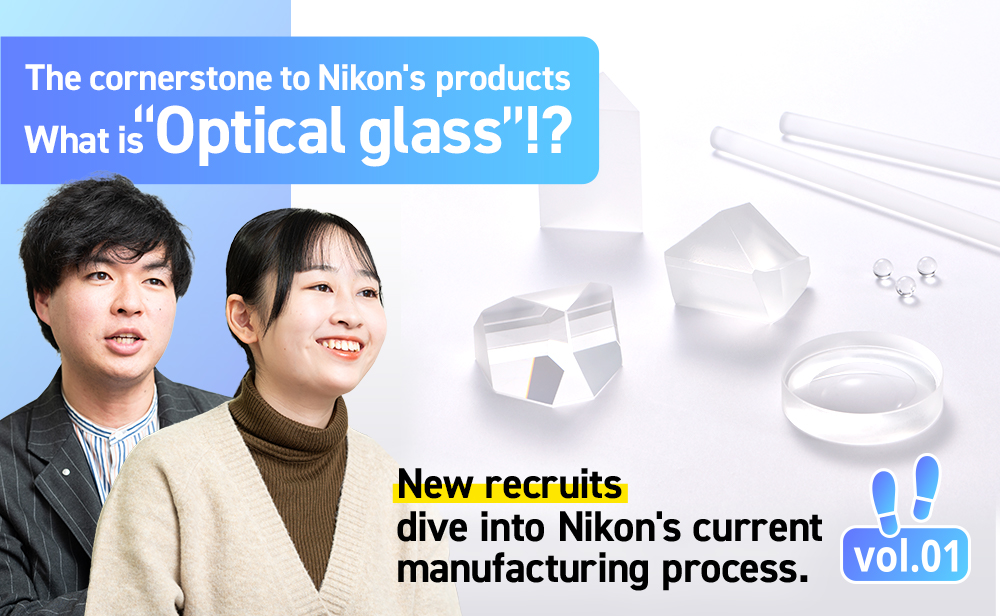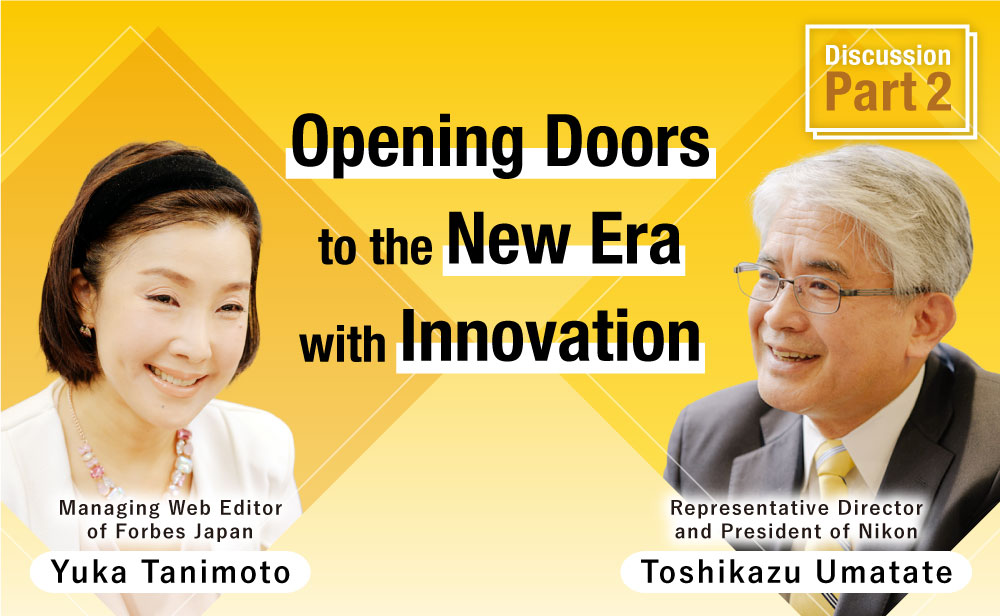
【IR Conference 2022 Report】 Shifting from Business Recovery to Further Growth—Improvement of Corporate Value and Sustainable Management
- *The published content is as of the time of interview.
On Thursday, December 22, 2022, Japan Investor Relations Association (JIRA) and Nikkei Inc. co-hosted the IR Conference 2022 at Otemachi Place Conference Center. Nikon's Director and CFO Muneaki Tokunari participated in a panel discussion titled "The Source of Corporate Value and Sustainability." Within this panel, he explained how Nikon successfully recovered from the worst deficit in its history and how he approached discussions with investors. This article contains excerpts from his panel and highlights efforts as CFO to reform Nikon over time and improve corporate value.
INDEX
Three strategies that contributed to a V-shaped recovery from deficit

I became CFO of Nikon in April 2020, just as Japan declared its first state of emergency amidst the COVID-19 pandemic. That year, Nikon recorded the largest deficit in its over 100 years history and our stock price fell to 620 JPY—the lowest in 30 years—causing shareholders and investors a great deal of concern.
Today, however, we have successfully made a V-shaped recovery from this deficit, and our stock price has risen to roughly double the prior amount. To reach this point, Nikon executives conducted the following three strategies.
The first is optimization of balance sheets. We collectively executed sales of securities (including those under cross-shareholding) and recording of impairment losses on fixed assets.
Second is clarification of business strategy for our Imaging Products Business, which had been recording sales deficits for two consecutive years. We established a concrete strategy to focus efforts into mid-range to high-end equipment geared towards professionals and hobbyists, mirrorless cameras in particular. We were able to achieve great success with our flagship mirrorless camera, the Z 9, which was awarded Camera of the Year in the Camera Grand Prix 2022. Additionally, the fashionable and retro design of our Z fc gained popularity among younger generations and female customers. These results contributed to the full recovery of Nikon's Imaging Products Business.


Thirdly, we established new pillars to generate profit. State-of-the-art semiconductors are currently created with lithography systems that utilize light called extreme ultraviolet (EUV). Nikon is responsible for the development and manufacture of components for equipment used to inspect photomasks (the original semiconductor circuit boards that are burned onto silicon wafers) used in the EUV lithography systems of ASML in the Netherlands, which dominates the market share.
As shown in this example, we focused on a business model centered around "growing with our customers," utilizing Nikon's technologies to provide parts and optical components, rather than pursuing all-inclusive finished products. As a result, operating profit of our newly established Components Business grew exponentially, jumping from 100 million JPY in FY2020 to 12.7 billion JPY in FY2021. For this term, we expect to record an operating profit of 18 billion JPY.
Regaining trust by focusing on interactions with the investor community

These efforts helped our business performance to recover, but the same cannot be said for our stock price, which still remains low with a price-to-book (P/B) ratio below 1. To raise stock prices even further, we believe it is necessary to boost our price-to-earnings (P/E) ratio.
To achieve this, we will need to decrease our cost of capital and raise our expected rate of return.
Since my appointment as CFO, we have achieved nearly every prospect presented to investors in terms of business performance, and we have delivered all of our disclosed plans for shareholder returns. We have also assertively communicated with the investor community, and I'd like to believe we've regained a substantial amount of trust in Nikon's management.
By gaining the trust of investors and managing our business without surprises, I believe we can improve business predictability for investors, and in turn, decrease cost of capital for the company.
Ever since my days as CFO of Mitsubishi UFJ Financial Group, I've expressed to members of our IR team that "IR is equivalent to sales." This is because I believe that if IR activities can help cut cost of capital, we can boost our P/E ratio even with the same profits, raising stock prices in return.
On the other hand, raising our expected rate of return does not come as easily. Thus, we must clearly establish areas for growth and invest in human and financial resources to commit to and appeal its growth as a company overall.
At Nikon, we consider growth strategy as being one with sustainability strategies. Whether a specific business will contribute to solving environmental and social issues is the singular most important aspect in its formulation. We hope to utilize applied optics and precision technologies and realize business growth by contributing to society and the environment, as stated in one of our twelve materialities: "Creating social value through core technologies."

Simultaneously executing sustainable management and growth strategy
Nikon actually has been acclaimed by external parties for its ESG activities, which were evaluated as equal or excellent compared to other companies in the same industry. For example, the Dow Jones Sustainability Indices "DJSI World" is a global ESG investment indicator that is composed of 332 companies across the globe, including a small sample of 36 from Japan. Of these, Nikon has been selected as a company with excellent ESG indicators for five years in a row. Additionally, Nikon's shares have been approved for all five indices for ESG investment by Government Pensions Investment Fund (GPIF), including empowering women and carbon efficient.(As of December 22, 2022)
These ESG efforts will serve as the foundation to our growth strategy as we contribute to society through creativity and innovation.

On another note, please allow me to introduce Nikon's efforts to improve energy efficiency within society through fine processing utilizing optics. These are specific case studies of Nikon's work to utilize core technologies to solve environmental (E) and social (S) issues.
Nikon is working to improve fuel efficiency and reduce carbon emissions through its original optical processing machines. These machines have been adopted on aircrafts of ALL NIPPON AIRWAYS CO., LTD. (hereinafter "ANA"), in which riblet-processed films were applied to the aircraft's surface to resemble grooves on shark skin, which help them to swim faster in the ocean. Hypothetically, applying this film to 80% of the aircraft's surface will save fuel by 2%. If adopted for all of ANA's aircrafts, it is estimated to save a total of 8 billion JPY worth of fuel and 300,000 tons of CO2 annually.
In fact, we have begun collecting data of this technology on two green-painted aircrafts named the "ANA Green Jet" since its adoption in October 2022.
- *Regarding Nikon's "efforts to improve energy efficiency in society with microfabrication technology utilizing light," we have also conducted flight tests on aircrafts by Japan Airlines Co., Ltd. For details, please refer to the press release "JAL, JAXA, O-Well, and Nikon Conduct Flight Test with Aircraft for which the World's First Riblet Shape was Applied over External Paint" released on February 28, 2023.

Through efforts like these, Nikon hopes to utilize its core technologies and realize the wellbeing of the Earth and of society, while simultaneously achieving its sustainability and growth strategies—my message to investors has been precisely this.
The pillars that support this growth strategy are "economic capital" and "human capital."
Let me first introduce our allocation of economic capital. We believe Nikon can generate distributable resources amounting to roughly 700-800 billion JPY within the duration of our Medium -Term Management Plan. Of this amount, we have disclosed that 90% will be invested towards corporate growth, including strategies, R&D, and capital expenditures, while the remaining 10% will be used towards shareholder returns.
It is our mission at Nikon to create something completely new that does not yet exist in the world or in society, and we believe investors anticipate the same. Therefore, as a company based on research and development, we decided to clarify and openly declare allocating roughly 90% of our capital towards growth.
In terms of human capital, we are focused on rewarding our employees on their accomplishments more than ever. In order to continue attracting diverse workers with advanced expertise, in September 2022, we announced plans to raise the annual salary of our employees by an average of roughly 3% and up to 20% per person (compared to the current system). We are also constructing our new headquarters in Shinagawa Ward. By gathering a large number of excellent employees at the heart of Tokyo, we hope to realize the full potential of diverse skill sets and move towards becoming "a key technology solutions company in a global society where humans and machines co-create seamlessly."

My role as the CFO is to communicate these non-financial reforms, including medium- to long-term vision and human capital management, to investors as clearly and specifically as possible.
From this standpoint, Nikon held its first IR Day in May 2022, to which we saw a 7% increase in stock prices the following day.
We also received positive feedback from our own division leaders and executives that presented at the event, who felt they were better able to reflect and update growth strategies as they prepared to communicate business plans in their own words.
Co-creation between companies and investors to develop Japan's economy
I hope to borrow the help of investors to boost our corporate value.
An incredibly unique institutional investor located overseas comes to mind. They possess excellent research skills and have thoroughly analyzed Nikon's technologies to understand our strategies, to which they then propose other technology companies for us to partner with.
Thanks to the introduction of this institutional investor, we've actually invested in an overseas company in the genetics field, and we are currently pursuing development of a joint business in the healthcare field. This company has been funded by some of the world's most prestigious companies and investors, including foreign sovereign wealth funds, but in Japan, Nikon was its sole shareholder prior to listing.
In order for companies to grow and economies to expand, I believe it is important for companies to communicate with investors as players in the capital market, in a less formal and more in-depth manner.
However, we must also be aware of the fact that companies and investors work under different time frames. Many Japanese companies are looking to build competitiveness to maintain their global presence and create products that can be utilized around the globe. This is the same for Nikon—we have acquired market shares globally through creating new innovations, such as our semiconductor lithography systems and digital cameras.

When I joined the company two years ago, I referenced our corporate history book, Nikon's 100-year History, to study our businesses rooted in these innovative technologies. What I found was that it took roughly 20 years for these businesses to generate profit, dating back to its conception.
I sincerely hope investors can understand this time frame in relation to Nikon's strategies, and support our company from a long-term perspective.
At the same time, my message towards our employees as CFO has been to turn a profit at a much faster pace, as investors anticipate quick returns and typically invest for 3-5 years at most.
Like this, CFOs must make both internal and external efforts to bridge the difference in time frames between investors and companies.
I hope to realize a future in which investors and companies can work together to improve Japan's economy.
Sustainability
Nikon's approach to and initiatives for sustainability.
Investor Relations
Nikon's latest Investor Relations information.
Originally published: April 20, 2023.



